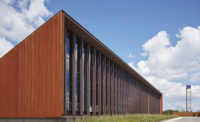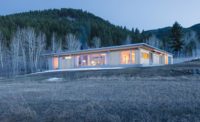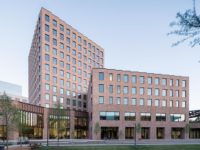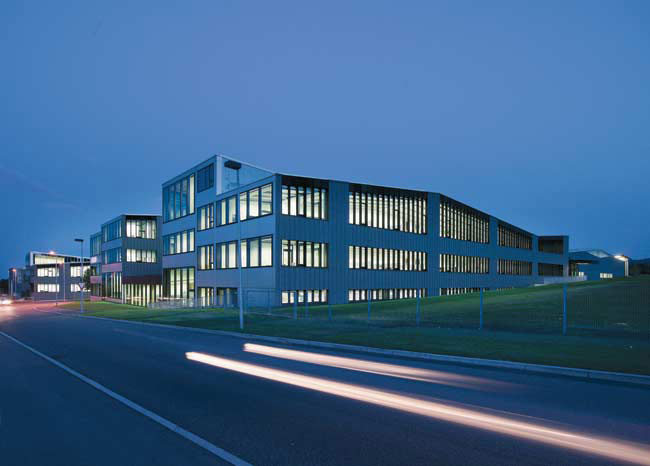Trumpf Campus by Barkow Leibinger Architects
Stuttgart, Germany

A gatehouse completed in 2007 features a dramatic cantilever that alerts visitors to the innovative architecture on the campus.

The laser machine-tool factory from the 1990s and a Development Center from 2009 occupy former farmland on the west side of the campus.
Photo © Volker Arnold

North light helps animate spaces inside the Development Center.
Photo © Christian Richters

For the campus restaurant, the architects used digital fabrication technologies that they learned from Trumpf itself.

Aerial view of Trumpf Campus
Photo © Volker Arnold

Trumpf Campus Gatehouse

Trumpf Campus Gatehouse

Trumpf Campus Gatehouse

Trumpf Campus Gatehouse double façade detail
Photo courtesy Barkow Leibinger Architects

Trumpf Campus Development Center
Photo © David Franck

Trumpf Campus Development Center interior

Trumpf Campus Laser Machine Tool Factory
Photo © Margherita Spiluttini

Trumpf Campus Restaurant
Photo © Christian Richters

Trumpf Campus Restaurant
Photo © Christian Richters

Trumpf Campus Restaurant
Photo © Christian Richters

Trumpf Campus Restaurant
Photo © Christian Richters

Trumpf Campus Development Center, panorama

Trumpf Campus Gatehouse detail
Image courtesy Barkow Leibinger Architects

Trumpf Campus Masterplan Development
Image courtesy Barkow Leibinger Architects

Trumpf Campus site plan
Image courtesy Barkow Leibinger Architects

Trumpf Campus site section
Image courtesy Barkow Leibinger Architects

Trumpf Campus Development Center section A-A
Image courtesy Barkow Leibinger Architects

Trumpf Campus Development Center section B-B
Image courtesy Barkow Leibinger Architects

Trumpf Campus Development Center section C-C
Image courtesy Barkow Leibinger Architects

Trumpf Campus Gatehouse sections
Image courtesy Barkow Leibinger Architects

Trumpf Campus Restaurant section A-A
Image courtesy Barkow Leibinger Architects

Trumpf Campus Restaurant, section B-B
Image courtesy Barkow Leibinger Architects

Trumpf Campus Gatehouse floor plan
Image courtesy Barkow Leibinger Architects

Trumpf Campus Restaurant floor plan, level one
Image courtesy Barkow Leibinger Architects

Trumpf Campus Restaurant floor plan, level two
Image courtesy Barkow Leibinger Architects

Trumpf Campus Restaurant, roof modules
Image courtesy Barkow Leibinger Architects































Architects & Firms
From 1997 to 2010, Berlin-based Barkow Leibinger Architects worked on the master plan and architecture of an industrial campus that breaks down the traditional divide between “blue”- and “white”-collar workers and establishes a flexible blueprint for future growth. Located in Ditzingen, outside of Stuttgart, the expanded and reorganized campus has helped the Trumpf Group become “the world’s leading machine-tool manufacturer” and grow to 7,000 employees around the globe, state the architects. In addition, the company’s recent success at exporting its products has allowed it to weather the current economic storm without laying off any employees, says Barkow Leibinger.
Instead of applying a single corporate identity to the entire campus, the architects imbued each phase in the master plan with a degree of “autonomy” based on its programmatic needs and design expression. They also developed a “soft master-planning” approach that allows the company to adapt to changing needs and future acquisitions while enjoying a holistically conceived complex.
The first two phases, in the late 1990s, involved building a new laser machine-tool factory and then a technical systems facility on the west side of the campus. The new buildings brought together production halls, offices, and laboratories, eliminating the usual hierarchies of corporate rank. In the first part of the 21st century, Barkow Leibinger designed a new Customer and Administration Building, a gatehouse with a dramatically cantilevered canopy, and then a campus restaurant with an attention-grabbing ceiling made of polygonal cells set within a triangular steel frame. The firm also renovated an existing spice factory on the east side of the campus and expanded it.
Underground tunnels connect the entire campus and allow people to move around in all weather. By converting old buildings to new uses, incorporating energy-saving technologies, and applying sustainable design strategies, the architects say they help the company reduce operational costs. And by creating a workplace that instills pride in employees, they improve performance and help the company attract and retain the best talent.
Architect:
Barkow Leibinger Architects
Schillerstraße 94
10625 Berlin | Germany
fon: +49.30.31 57 12 -0 | fax: -29
info@barkowleibinger.com
Location:
Stuttgart, Germany
Completion Date: September 2009
Total construction cost: $194 million
Gross square footage:
964,070 sq.ft. (total planning area: 1,819,100 sq.ft.)
PeopleOwner: Architect: Personnel in architect's firm who should receive special credit: Development Center: Team [Construction Phase] Gatehouse: Team [Construction Phase] Restaurant: Team [Construction Phase] Engineer(s): Campus Restaurant & Events Ctr: Structural Engineering: Werner Sobek Ingenieure, Stuttgart, Germany; Climate Engineering/Energy Performance: Transsolar ClimateEngineering, Stuttgart, Germany; Mechanical Engineer HVAC: Krebs Ingenieure, Ditzingen, Germany; Electrical Engineers: IBB Ingenieure, Berlin, Germany; Management: Gassmann + Grossmann, Stuttgart, Germany Gatehouse: Werner Sobek Ingenieure, Stuttgart Consultant(s): Lighting: Müller & Bleher, Filderstadt, Germany Acoustical: Horstman & Berger, Altensteig, Germany Other: Gatehouse: Lighting: Studio Dinnebier, Berlin Other: Façade: Arup Berlin (Concept) | Werner Sobek Ingenieure, Stuttgart (Construction) Restaurant: Lighting: Bartenbach LichtLabor, Innsbruck, Austria Other: Color Concept: Friederike Tebbe, Berlin Photographer(s): David Franck © Margherita Spiluttini: ©Spiluttini#8528:B.tif | ©Spiluttini.halle.tif | ©Spiluttini8527A.tif Margherita Spiluttini Fotografie Gatehouse: David Franck © Zooey Braun: ©Braun196-07_A4.tif ZooeyBraun Fotografie Restaurant: David Franck © Christian Richters: ©Richters_3961-09.tif | _3961-23.tif | _3961-47.tif | _3961-10.tif | _3961-24.tif | cr3961-16.tif Represented by: © Amy Barkow: BarkowPhoto_8690.tif | BarkowPhoto_8712.tif | BarkowPhoto_9065.tif Amy Barkow CAD system, project management, or other software used: Vectorworks (CAD) |
ProductsStructural system Exterior cladding Other cladding unique to this project: (Restaurant) exterior and interior custom tiles, NBK; ceramic, Architectural Terracotta; Roofing Windows Glazing Construction Windows Single glazing with „g-Wert“ 73% Plexiglas Mullion Sunscreen Plexiglas Arrangement Hardware Other special hardware: (Development Center) Fittings - FSB, Kaba, DORMA Interior finishes Wall coverings: (Gatehouse)Tiles lavatories 2.5x2.5 cm, turquoise / Cinca; (Development Center) Tiles – colors/Vidrepur, Unit One/Villeroy & Boch® Plastic laminate: (Development Center) Caoutchouc: Norament 925 / Nora® Floor and wall tile: (Restaurant)serving area and entrance tunnel - custom ceramic wall tiles: NBK Ceramic - Architectural Terracotta; (Gatehouse) Natural stoneGranit, China, Shanxi Black, mottled, Size ca. 700x400 mm; thickness interior: 30 mm / exterior: 60mm, Besco - Berliner Steincontor; (Development Center) Floor tiles: Pro Architectura 2200 / Villeroy & Boch, Plural Optima / Agrob Buchtal Carpet: (Development Center) Strong Modul 961 / Armstrong® Special interior finishes unique to this project: (Restaurant) screed flooring - BASF Bautechnik GmbH Textiles: (Development Center) Office partition walls: Kvadrat, Antiglare: Silent Gliss® Furnishings Office furniture: (Development Center) Work Station: tables: VS-Möbel, Partition walls: Vitra, Apothecary cabinet: Vitra, Sideboards: König & Neurath Reception furniture: (Gatehouse) Reception desk - glued timber construction, Counter front: stainless sheet 3mm, Countertop: Desk Top® Eleganza 4023 black Chairs: (Restaurant)Vitra Tables: (Restaurant)Vitra Other furniture (use additional sheet if necessary): (Gatehouse)wallcovering - Melanime resin coated chipboard, decor white, laminated with Plexiglas GS003, 6mm; (Development Center) Conference rooms - tables: Vitra, Chairs: Castelli / Haworth®, Built-in furniture: Zeeb Innenausbau GmbH Lighting Downlights: (Development Center) Mawa Design Other: |





































